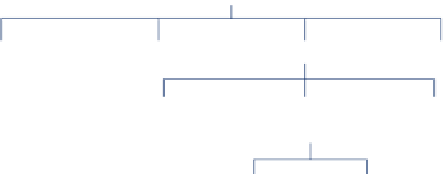Biomedical Engineering Reference
In-Depth Information
Gene therapy
Gene replacing
Gene swapping
Gene silencing
Gene repairing
Antisense
oligonucleotides
RNA
interference
Ribozyme
technology
siRNA
microRNA
Figure 7.1.
Various strategies of gene therapy.
7.4 Barriers to Oligonucleotide and siRNA Delivery
Though antisense technology holds great therapeutic potential, several barriers
(
Fig. 7.2
) often impede delivery of AS ODNs and siRNA to their site of action. The
barriers encountered by naked oligonucleotides and siRNA are different from those
encountered by the ones associated with various nanocarriers. To elicit a pharma-
cological response, an antisense agent must reach the tissue of action from the gen-
eral circulation, invade the diseased cells there, and interact with the complementary
mRNA, following endosomal release, thereby inhibiting the expression of the desired
protein. However, the large size and ionic nature of the oligonucleotides and siRNA
impede them from efficiently traversing the various biological membranes [22]. Here
we discuss the various barriers encountered by the administered AS ODNs, which
have also been studied extensively for siRNA, and the possible ways to overcome
these barriers for efficient delivery. The ultimate target and the action of AS ODNs
and siRNA are the same, and thus the barriers, challenges, and remedies discussed
for one applies more or less for the other too.
7.4.1 Physiological Barriers
While traveling from the site of administration to the site of action, antisense agents
cross various physiological enzymes and compartments that affect the extent and
efficiency of their delivery to the target.
7.4.1.1 Degradation by Nucleases
Following administration, the first biological barrier an oligonucleotide faces is pre-
sented by the nuclease activity in blood and tissues. Within 1 min, nearly 70% of
the administered antisense molecule degrades, resulting in low gene silencing
[35]
.
Chemical modifications and use of nonviral vectors can drastically improve the sta-
bility of the oligonucleotide toward nucleases in the biological system
[18,36-39]
.
Remarkable modifications can be done at the 2-OH position of pentose sugars and
the 3 half of the siRNA structure. The substitution of sulfur for oxygen to form












Search WWH ::

Custom Search